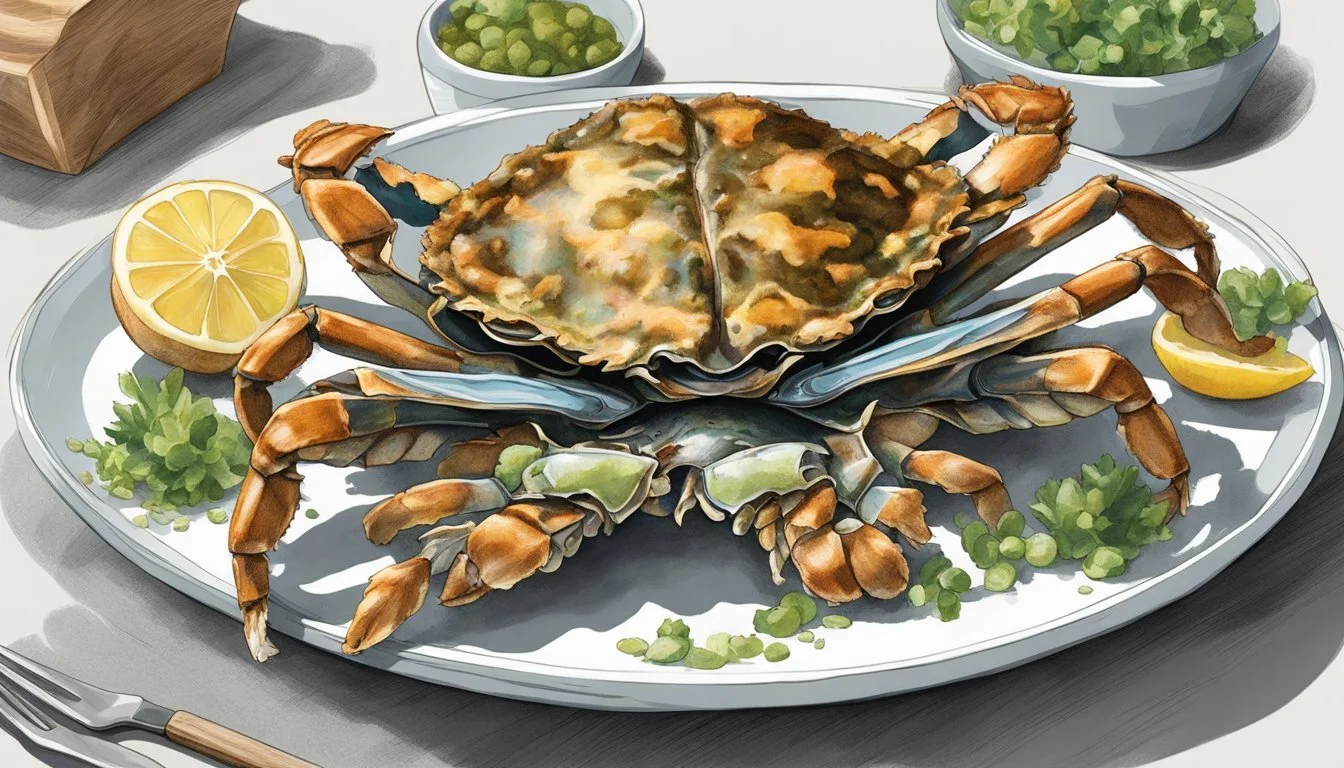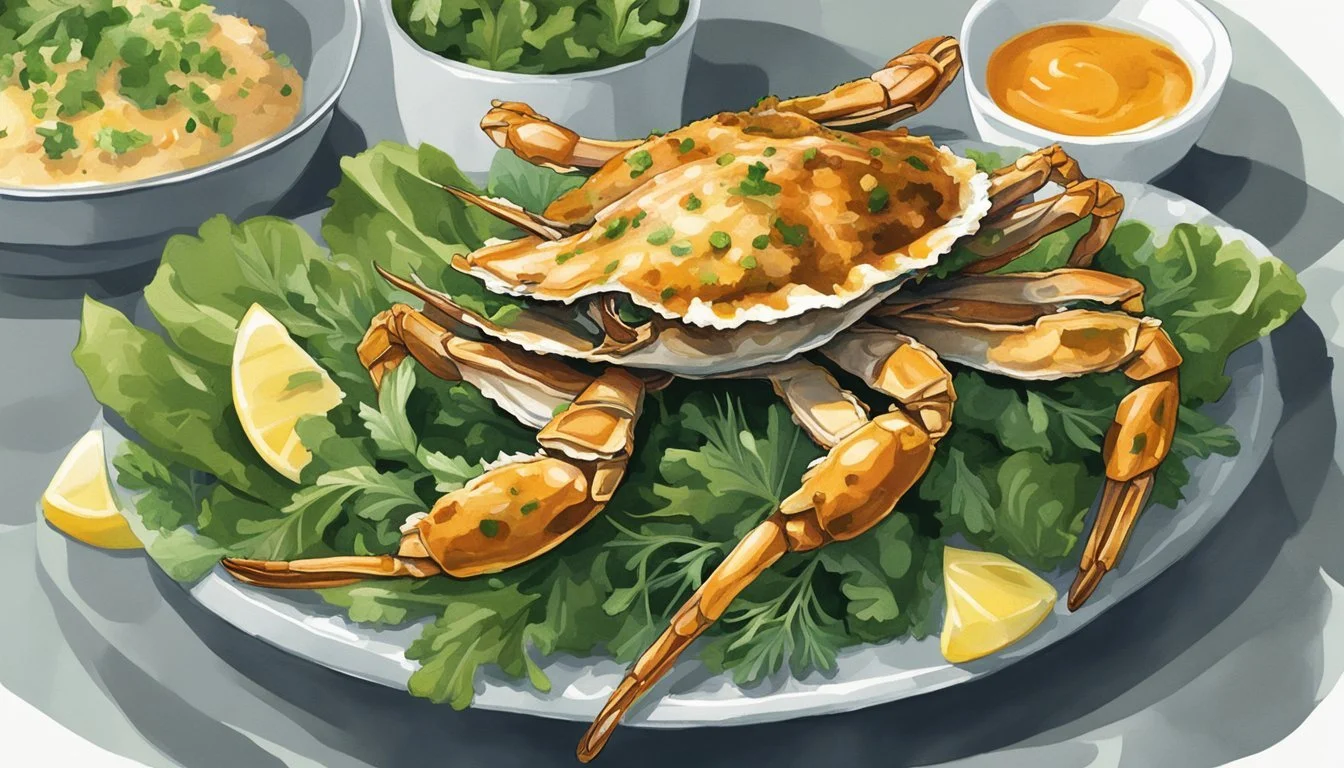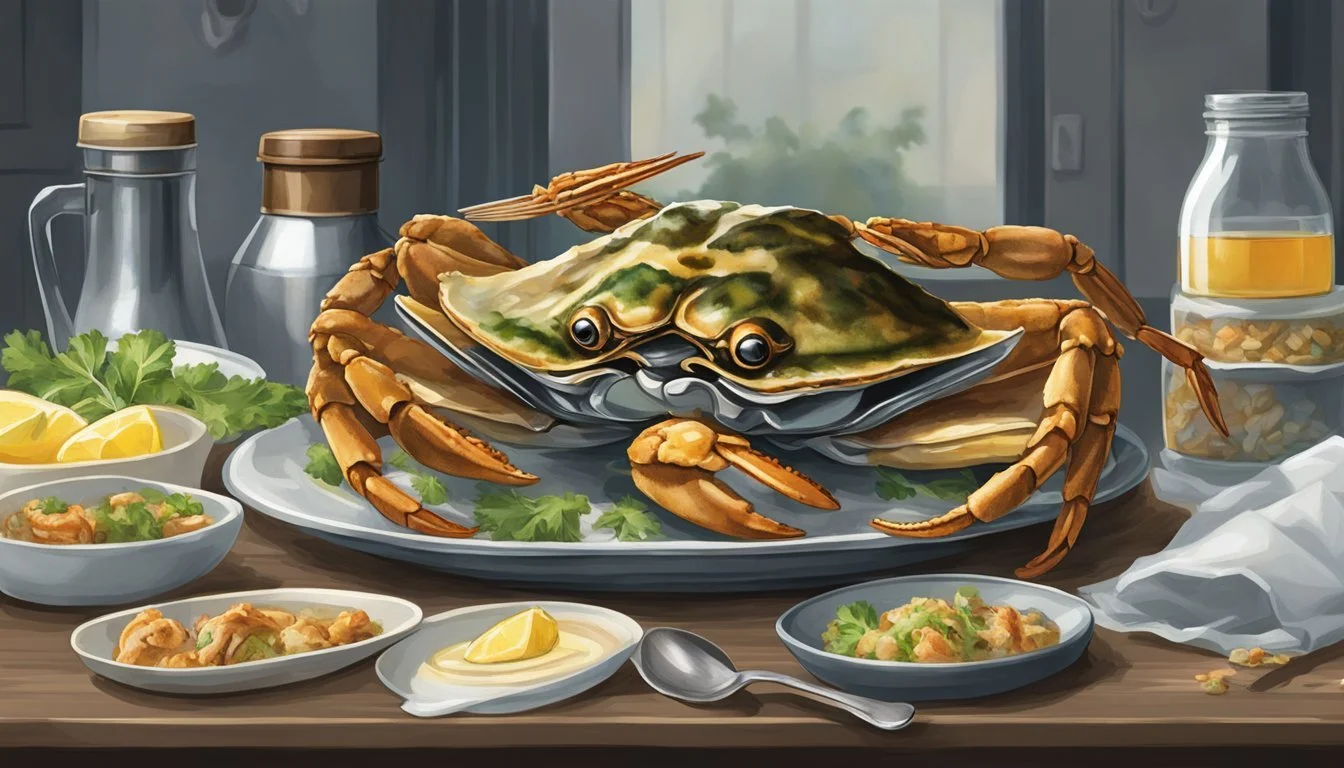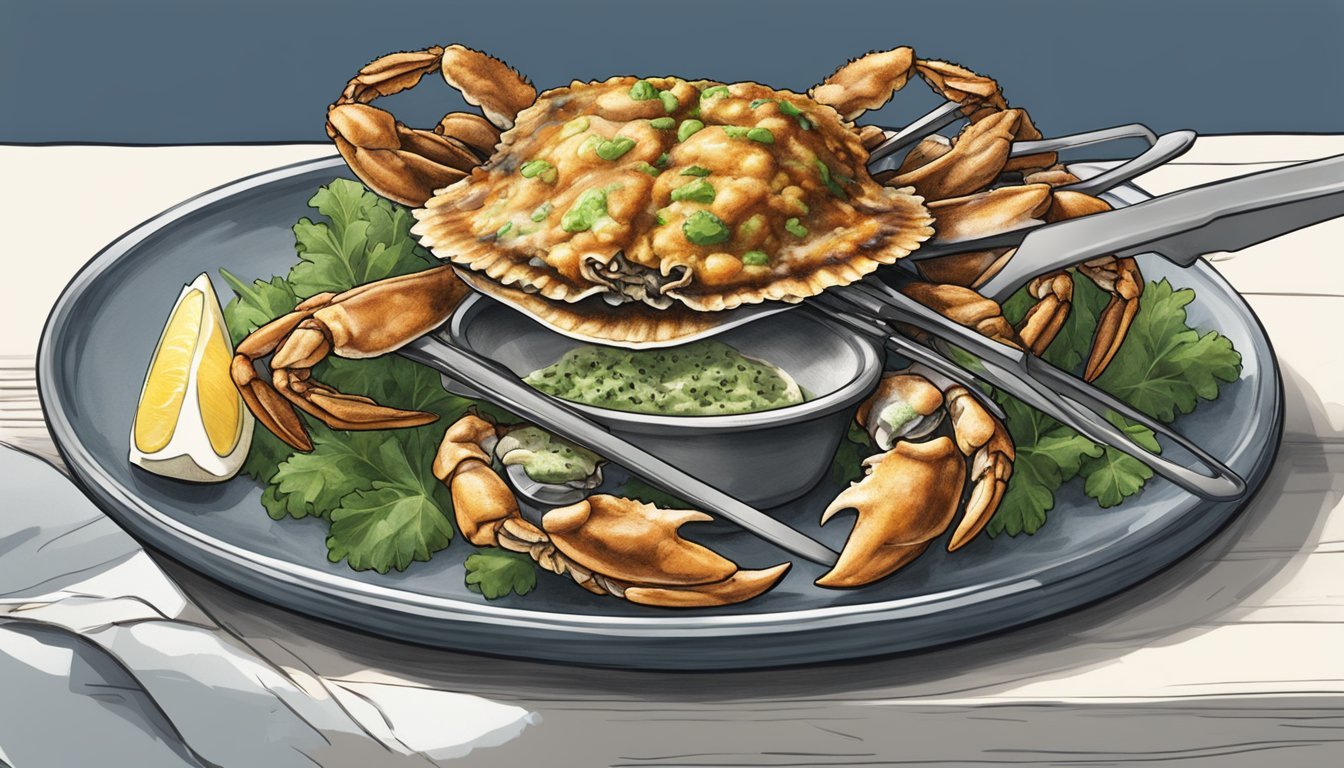How Do You Eat a Soft-Shell Crab?
A Simple Guide to Enjoying This Delicacy
Soft-shell crabs (What wine goes well with crab?), a delicacy enjoyed by seafood aficionados, are essentially blue crabs that have recently molted their outer shell. During molting, the crabs shed their hard exoskeleton to grow a new, larger one. It is during this small window of time, when their new shell has not yet hardened, that they are harvested. This period provides a unique culinary experience as the entire crab, minus its gills, mouthparts, and abdomen, can be consumed. Soft shell crab season typically starts in early spring and extends through summer, coinciding with the crabs' natural molting cycle.
Understanding how to eat soft-shell crabs is crucial for those looking to enjoy this seasonal delicacy. Diners can savor the entire crab without the labor-intensive process of cracking and peeling that comes with hard-shelled crabs. Often found in coastal areas where blue crabs are native, these crabs are prepared by first removing the inedible parts. They are then typically cooked by methods that turn their thin, pliable shells into a crispy texture, enhancing the flavor and making them enjoyable to eat.
The versatility of soft-shell crabs in various cuisines makes them a popular choice among chefs and home cooks alike. Whether deep-fried, pan-fried, grilled, or broiled, these crabs can be served in a variety of dishes. Their unique texture and rich flavor profile allow them to stand out in simple preparations or complement more complex recipes, making them a favored ingredient when in season.
Understanding Soft-Shell Crabs
Soft-shell crabs are blue crabs that have recently molted, offering a unique culinary experience. These crabs are delicacies particularly found along the Atlantic coast, including the Chesapeake region, and are sought after for their tender texture and ease of consumption.
Biology of Molting
Soft-shell crabs are in fact blue crabs (Callinectes sapidus) that have shed their old exoskeleton in a natural growth process known as molting. During molting, the crab's new shell is soft, providing a small window of time during which the crab can be consumed whole. After a crab molts, it absorbs water to expand its new shell; within a few days, the shell will harden. Commercially, they are often kept in saltwater tanks and monitored to ensure they're harvested when the shell is still soft but the crabs are alive and fresh.
Seasonality and Harvesting
The peak season for soft-shell crabs is from late spring to early fall, correlating with warmer waters which stimulate the molting process. In regions like Maryland and along the Gulf of Mexico, this peak occurs between May and September. Harvesting involves careful timing; crabbers monitor closely to determine when the crabs have molted and then remove them from the water before their new exoskeleton hardens. This quick transition from ocean to table ensures maximum freshness.
Selection and Purchase
When venturing to buy soft-shell crabs, consumers should prioritize freshness and quality, be it from live or previously frozen selections. Here's how to ensure you choose the best crabs, whether you're handling them live or opting for frozen convenience.
Choosing Fresh Crabs
One should seek soft-shell crabs at reputable seafood markets or fishmongers, as they often offer the freshest options. Freshness is indicated by the crab's appearance and aroma; the crabs should look lively and have a clean, sea-fresh smell. Avoid any with a fishy or off-putting odor. The belly of fresh soft-shell crabs should feel firm, signaling that they are full of meat.
Appearance: Bright, clean, firm to the touch
Smell: Ocean-like, without any unpleasant fishiness
Touch: Firm belly, indicating a meaty interior
Handling Live Crabs
When buying live soft-shell crabs, one must handle them with care to ensure they remain in good condition until they're ready to be cooked. Live crabs should be kept in a moist environment within the fridge, not submerged in water, and used within two days of purchase. They are typically more perishable than their hard-shell counterparts, requiring careful storage.
Storage: Moist, cool environment in the fridge
Usage: Cook within two days of purchase
Opting for Frozen Crabs
Consumers may also opt for previously frozen soft-shell crabs, which can be a convenient choice without significantly compromising on flavor or texture. When selecting frozen crabs, ensure the packaging is airtight and undamaged. Thawing should be done in the refrigerator for several hours or overnight to maintain quality.
Packaging: Ensure it is airtight and intact
Thawing: Refrigerator thawing is preferable for retaining quality
Preparation Before Cooking
Before one can enjoy the unique taste of soft-shell crabs, proper preparation is essential. This includes a thorough cleaning process to remove inedible parts and assembling key ingredients that will enhance the crabs' natural flavors during cooking.
Cleaning Process
One begins by using kitchen shears or scissors to cut off the front part of the crab, which includes the eyes and mouth. It's important to lift the top corners of the shell to reveal the gills, which are also known as the "lungs" or "feathery gills." These should be removed since they aren't edible. The tail flap on the underside of the crab should be cut off as well. After removing these parts, the crab should be rinsed under cold water to clean any remaining internal parts.
Essential Ingredients
The following ingredients are typically used to season and cook soft-shell crabs:
Flour: For a light dusting over the crabs to help in achieving a golden-brown crisp upon cooking.
Milk: Often used to soak the crabs which can help the flour adhere better.
Seasonings: A combination of salt and freshly ground black pepper is mixed with flour to taste.
Butter: It adds richness to the dish and can be melted in the skillet to cook the crabs.
Garlic and Parsley: Finely chopped garlic and parsley can be added to the butter for additional flavor.
Lemon Juice: A squeeze of fresh lemon juice can be used to finish the dish before serving, enhancing the flavor with a bright acidity.
Cooking Techniques
Soft-shell crabs are a delicacy often enjoyed for their tender meat and edible shell. The key to a delicious soft-shell crab dish lies in the cooking technique used, which can greatly enhance the crab's flavor.
Frying the Crab
To fry soft-shell crabs, one can either pan-fry or deep-fry them. For pan-frying, one typically heats a small amount of oil in a large skillet over medium heat. The crabs are often dredged in flour or a mixture of flour and cornmeal, enhancing the final texture to a golden brown crispness. They are then cooked for approximately 3-4 minutes on each side. For deep-frying, the crabs are submerged in hot oil at around 365 °F (185 °C), usually after being coated in a batter made from milk, egg, and seasoned flour. This method results in a uniformly crispy exterior with a rich, well-cooked interior.
Grilling the Crab
Grilled soft-shell crabs offer a smokier flavor. To grill, one should first clean the crabs and lightly brush them with oil or melted butter to prevent sticking. The crabs are then placed over a medium-hot grill and cooked for about 4-5 minutes on each side. They are ready when their shell turns a reddish color and the meat inside is opaque.
Steaming the Crab
Steaming is a gentler cooking method that preserves the crab's natural flavors. For steaming, the crabs are placed in a steamer over boiling water and covered. They are usually steamed for 6-8 minutes. This method keeps the crab moist and tender. It's a more subtle preparation, letting the delicate flavor of the crab stand at the forefront.
Serving and Presentation
When serving soft shell crab, presentation is key to enhancing the dining experience. The vibrant colors of the accompaniments and the unique structure of the crab itself contribute to an attractive and appetizing dish.
Sandwich Assembly
The soft shell crab sandwich is a classic offering, particularly in coastal areas during crab season. To assemble the sandwich, a fresh roll is lightly toasted and matched with a spread of mayonnaise or tartar sauce. The crab, typically fried until crispy, is placed on the bun, allowing the legs and claws to protrude slightly. This creates a tempting visual with the promise of flavor and texture. Crisp lettuce and ripe tomato slices add freshness and color, contrasting with the golden crab meat.
Entrees and Accompaniments
For entrée presentations, soft shell crab is often the star of the plate. It can be prepared in various ways, but common methods include pan-frying or deep frying to achieve a crispy texture. The flavor of the crab, described as sweet and juicy, is best complemented with seasonal vegetables or a light, tangy coleslaw. Some chefs garnish the dish with capers (What wine goes well with capers?) or a spritz of lemon juice to elevate the inherent flavor of the soft shell crab.
Visual Appeal
In a restaurant setting, the presentation of soft shell crab on menus is as important as the dish itself. Chefs strive for a balance between visual appeal and taste. Whether the crab is featured in a sandwich, served over a bed of greens, or presented as an entrée with side dishes, it should appear buttery and bright, with a visible crispness to the shell that hints at the texture diners will enjoy. The dish is often garnished in a way that highlights the season, flavor, and freshness, leaving a memorable impression on the diner.
Aftercare and Storage
Proper storage techniques are critical in maintaining the quality and safety of soft-shell crabs. Once the culinary treat of soft-shell crabs has been enjoyed, any leftovers need careful handling, just as with the initial storage before cooking.
Storing Leftovers
Leftover soft-shell crabs should be stored in the fridge as soon as possible. Place them in a shallow airtight container or wrap them tightly in cellophane to prevent air exposure. They should be consumed within 1-2 days for the best quality and taste. Regular observation is essential to ensure that they have not spoiled before reuse.
Freezing and Shelf Life
For those wishing to extend the shelf life of soft-shell crabs, freezing is a viable option. To freeze, one must ensure the crabs are cleaned, then wrap them individually with a cling film before placing them in a freezer bag, expelling all air to prevent freezer burn. Soft-shell crabs can be kept frozen for up to six months while maintaining a desirable quality. Always thaw them in the refrigerator overnight before use, not at room temperature, to minimize the risk of bacterial growth.
Culinary Variations and Influence
Soft-shell crab dishes exhibit a patchwork of regional styles and are a testament to the creativity and tradition of various cuisines. Each region imparts its unique flair to these delicacies, using local ingredients and time-honored techniques to elevate the dining experience.
Regional Preparations
Florida and Louisiana, with their proximity to the Gulf of Mexico, have deep-rooted seafood traditions that prominently feature soft-shells. In Florida, one might find soft-shell crabs lightly battered and fried with a scattering of garlic powder and cayenne to give that kick of heat. On menus across Louisiana, the soft-shells are often dredged in cornmeal before frying, providing a distinctive crunch and golden color that is beloved in Southern cuisine.
Moving up the East Coast, particularly in Maryland, soft-shell crabs are a seasonal highlight. The crabs are typically sautéed in butter, showcasing their inherently sweet flesh. Restaurants like the famed Grand Central Oyster Bar in New York City might serve them in a myriad of ways, from traditional frying to more contemporary presentations that reflect the diverse tastes of the Atlantic coast.
Incorporation in Cuisine
Chefs in restaurants across the United States creatively incorporate soft-shell crabs into their menus, often reflecting the culinary landscape of their region. They might be served between slices of bread as a sumptuous sandwich filling – a Maryland classic. In other areas, they appear atop rich pastas or as the crown jewel in a salad, each preparation celebrating the soft-shell crab's versatility.
Whether deep-fried in pots of oil until perfectly crispy or broiled with precision, soft-shells are a treasured ingredient. Their ability to adapt to a range of flavors and cooking methods has secured their place on American menus, marking the culinary influence of these unique crustaceans.
Health and Nutrition
Soft-shell crabs are a culinary delicacy, often enjoyed for their delicate texture and the convenience of being edible whole. When consuming soft-shell crabs, diners reap the benefits of the crab's nutritional content, which includes a suite of vitamins, minerals, and omega-3 fatty acids that are beneficial to health.
Nutrition Facts of Soft-Shell Crab (Coated and Fried, per 100-gram Serving):
Calories: 223
Fat: 11g
Carbohydrates: 10g
Sodium: 693mg
Protein: High
While enjoying soft-shell crabs, it is crucial to consider the mode of preparation, as frying can increase the fat content. Alternatively, baking or grilling may offer a healthier option. This crustacean is also a source of B vitamins, particularly vitamin B12, which supports neurological function, and pantothenic acid, which aids in the metabolism of food.
The presence of selenium in soft-shell crabs is noteworthy; it acts as an antioxidant, supporting the immune system. Additionally, as a seafood, soft-shell crabs contain omega-3 fatty acids, which have been linked to heart health.
Despite their nutritional benefits, soft-shell crabs can also be high in sodium and cholesterol. Individuals with dietary restrictions or health concerns should consider these aspects. Cuisine enthusiasts appreciate soft-shell crabs for their blend of gastronomic appeal and nourishing substances, making them a fragile but potent addition to a well-rounded diet.
Ethical and Environmental Considerations
When consuming soft-shell crabs, ethical and environmental considerations are paramount. Sustainable fishing practices help maintain crab populations and their habitats. Fishermen engaging in responsible harvesting contribute to the wellbeing of marine ecosystems. This involves adhering to regulations that protect against overfishing and ensure crab populations are able to replenish.
Observation and monitoring of crab stocks are essential. Fisheries should implement management plans that include:
Size limits to protect juvenile crabs
Seasonal restrictions to allow for mating and growth
Catch quotas to prevent overharvesting
Consumers interested in the sustainability of their seafood can look for certification labels from organizations such as the Marine Stewardship Council (MSC). These labels indicate that the seafood was harvested in a way that is mindful of environmental impacts and supports the ongoing health of the species.
Ensuring that soft-shell crabs come from fishermen who use eco-friendly methods also reduces bycatch, which is the unintentional capture of non-target species. Bycatch can be detrimental to other marine life and disrupt the balance of oceanic ecosystems.
The fascination with consuming soft-shell crabs must be balanced with a commitment to ethical practices. Consumers play a role by making informed choices that encourage sustainable harvesting, thereby helping to preserve the fascinating biological life cycles of these creatures and their environments for future generations.
Final Thoughts
Eating a soft-shell crab allows diners to enjoy the entire crustacean, offering a unique culinary experience. Flavor and presentation both play crucial roles in the enjoyment of this seafood delicacy. Proper cooking methods, such as frying, lead to a crispy texture that complements the softness of the edible shell.
The flavor of a soft-shell crab is delicate and should be preserved throughout the cooking process. Whether one opts for pan-frying or deep-frying, the goal is a golden-brown crispness that enhances the natural taste of the crab without overpowering it.
When it comes to presentation, serving the whole crab not only provides visual appeal but also assures diners of the freshness and quality of the seafood. Soft-shell crabs are often accompanied by light seasonings and sauces that highlight their flavor without detracting from the main ingredient.
For those preparing soft-shell crabs at home, some valuable information includes:
Ensuring the crab is cleaned properly, with all inedible parts removed.
Heating the cooking oil to the ideal temperature for an even fry.
Lightly coating the crab in a seasoned flour mixture for the perfect crust.
Remember, the simplicity of the dish is what makes it refined, allowing the crab's natural flavor to shine. Each bite should offer a combination of tender meat and the subtle crunch of the soft shell, making soft-shell crabs an exquisite choice for seafood aficionados.







